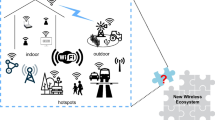Abstract
WiMedia, Wi-Fi, WiMax, Wi-Mobile, WiRAN, the Wi-family is getting bigger; so does the network architecture. It is encouraging to see the fast development of the new IEEE wireless technologies promising the ultimate Internet service deployment on wireless and mobile infrastructures since they would offer larger bandwidth at cheaper price compared to the telecommunication wireless radio resource. However it is disquieting to see that the TCP/IP protocol stack which is supposed to be the heart of the Internet services deployment is not evolving as fast as the wireless technologies do. Here we come up with the hard question which is the network performance of the TCP/IP architecture over wireless networks. It is probably too early to decide to replace TCP/IP by another protocol stack for wireless network support, but it is important to not ignore the problem and analyse the main drawbacks of TCP/IP in wireless networks and think about a new architecture of network communication over the wireless networks.
This paper provides a brief survey of what we name here the Wi-family wireless technologies, and emphasizes on new network architecture to optimize the TCP/IP behaviour worsen by the wireless characteristics.
Similar content being viewed by others
References
J. Ferber, Multi-Agent Systems: An Introduction to Distributed Artificial Intelligence. Addison Wesley Longman, 1999.
A.L.C. Bazzan, J. Wahle and F. Klügl, Agents in Traffic Modelling – From Reactive to Social Behaviour. KI'99, Bonn, Germany, LNAI 1701, pp 303–307 September 1999.
A. Moukas, K. Chandrinos and P. Maes, Trafficopter: A Distributed Collection System for Traffic Information. CIA'98, Paris, France, LNAI 1435 pp 34–43, July 1998.
J. Doran, Agent-Based Modelling of EcoSystems for Sustainable Resource Management. 3rd EASSS'01, Prague, Czech Republic, LNAI 2086, pp 383–403, July 2001.
A. Drogoul, B. Corbara and D. Fresneau, MANTA: New experimental results on the emergence of (artificial) ant societies”. In Artificial Societies: the computer simulation of social life, Nigel Gilbert & R. Conte (Eds), UCL Press, London, 1995.
L. Bensaid, A. Drogoul and T. Bouron, Agent-Based Interaction Analysis of Consumer Behavior. AAMAS'2002, Bologna, Italy, July 2002.
N. Minar, K.H. Kramer and P. Maes, Cooperating Mobile Agents for Dynamic Network Routing. In Software Agents for Future Communication Systems, Chapter 12, Springer Verlag, pp 287–304, 1999.
R. Roychoudhuri, et al., Topology discovery in ad hoc Wireless Networks Using Mobile Agents. MATA'2000, Paris, France. LNAI 1931, pp 1–15, September 2000.
E. Sigel, et al., Application of Ant Colony Optimization to Adaptive Routing in LEO Telecommunications Satellite Network. Annals of Telecommunications 57 (5–6) (May–June 2002) 520–539.
T. White, et al., Distributed Fault Location in Networks using Learning Mobile Agents. PRIMA'99, Kyoto, Japan. LNAI 1733, pp 182–196, December 1999.
E.L. Bodanese and L.G. Cuthbert, A Multi-Agent Channel Allocation Scheme for Cellular Mobile Networks. ICMAS'2000, USA. IEEE Computer Society press, pp 63–70, July 2000.
D.C. Verma, Simplifying Network administration using policy-based management, IEEE Network 16(2), 2002.
L. Merghem, D. Gaïti and G. Pujolle, On Using Agents in End to End Adaptive Monitoring. E2EMon Workshop, in conjunction with MMNS'2003, Belfast, Northern Ireland, LNCS 2839, pp 422–435, September 2003.
D. Gaïti and G. Pujolle, Performance management issues in ATM networks: traffic and congestion control, IEEE/ACM Transactions on Networking, 4(2), 1996.
H. Chaouchi and G. Pujolle, STP/SP: the solution for the TCP/IP crisis in the emerging wireless networks, IEEE PIMRC 2004, Barcelona, 2004.
Author information
Authors and Affiliations
Corresponding author
Rights and permissions
About this article
Cite this article
Pujolle, G., Chaouchi, H. & Gaïti, D. A global architecture for the Wi-family. Telecommun Syst 31, 163–173 (2006). https://doi.org/10.1007/s11235-006-6518-6
Received:
Accepted:
Issue Date:
DOI: https://doi.org/10.1007/s11235-006-6518-6




